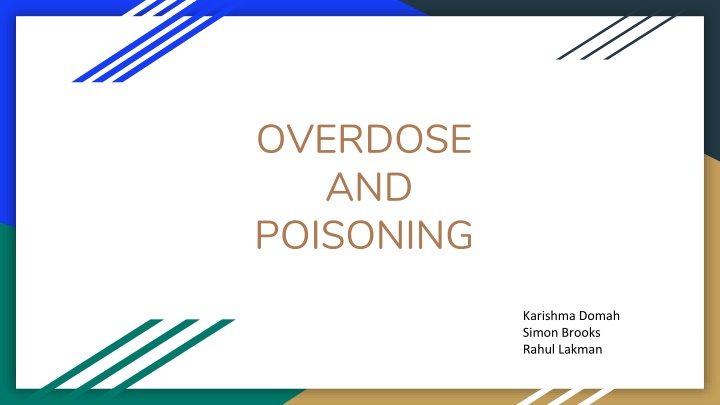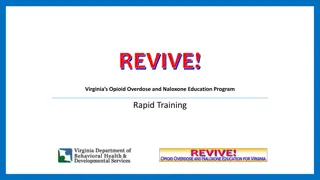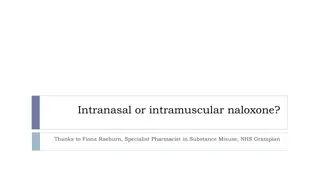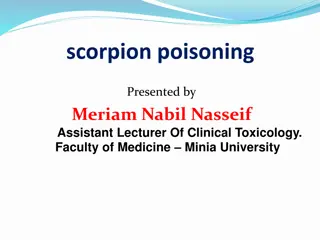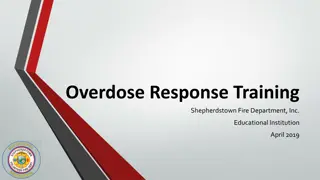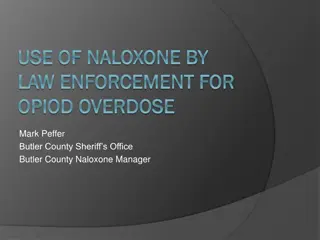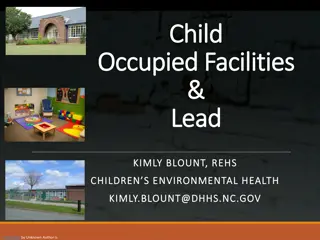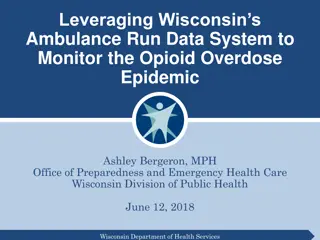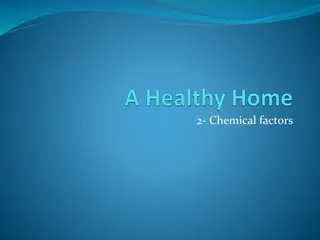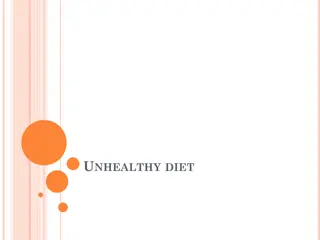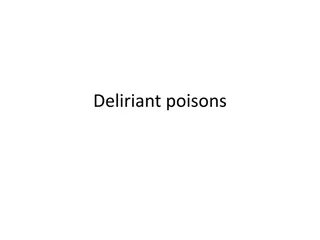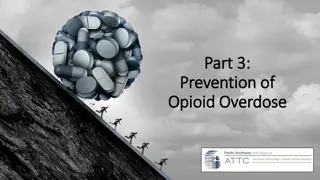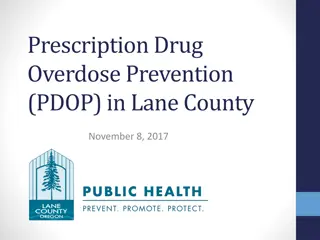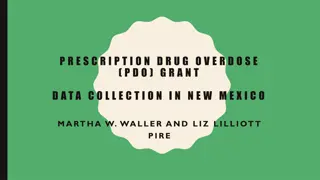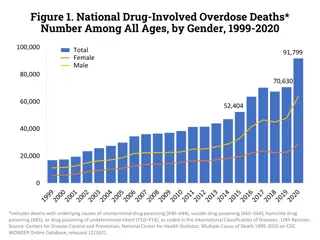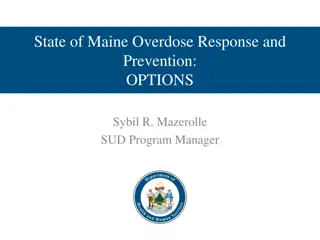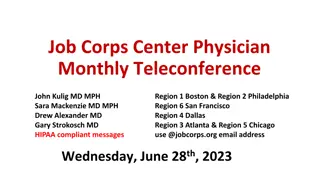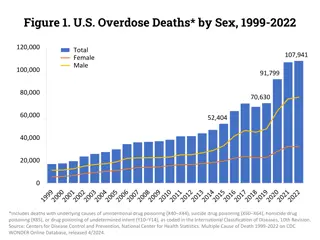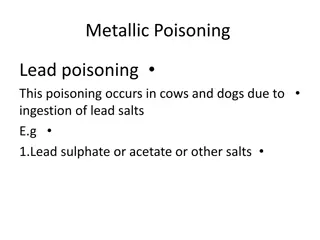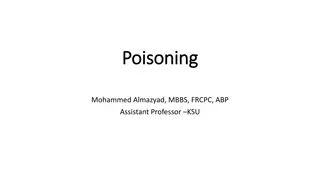Comprehensive Guide to Overdose and Poisoning Management
Poisoning and overdose are common occurrences with serious implications. They encompass various toxidromes and require a systematic approach covering risk assessment, resuscitation, investigations, supportive care, decontamination, antidotes, and disposition planning. Recognizing signs of poisoning or overdose is crucial for timely intervention and appropriate management.
Download Presentation

Please find below an Image/Link to download the presentation.
The content on the website is provided AS IS for your information and personal use only. It may not be sold, licensed, or shared on other websites without obtaining consent from the author.If you encounter any issues during the download, it is possible that the publisher has removed the file from their server.
You are allowed to download the files provided on this website for personal or commercial use, subject to the condition that they are used lawfully. All files are the property of their respective owners.
The content on the website is provided AS IS for your information and personal use only. It may not be sold, licensed, or shared on other websites without obtaining consent from the author.
E N D
Presentation Transcript
OVERDOSE AND POISONING Karishma Domah Simon Brooks Rahul Lakman
INTRODUCTION Poisoning and overdose is relatively common in our socioeconomic setting. Poison refers to a substance that is capable of causing harm or death when introduced or absorbed by the body. Overdose refers to the consumption or administration of a quantity of drug, in excess of the prescribed or usual dose. Both of which can be deliberate or accidental. Poisoning and overdose are grouped into Toxidromes. These are defined by the mental state, vital sign trends as well as other physical signs.
Contents 1. 2. 3. 4. 5. 6. 7. General approach to overdose and poisoning When to suspect poisoning Toxidromes Paracetamol INH Poisoning Warfarin poisoning Snake bites Cholinergics Anticholinergics Serotonin syndrome Opioids Sympathomimetics Sedatives Hallucinogens Salicylates Ethanol
GENERAL APPROACH TO OVERDOSE AND POISONING (RRSI DEAD) RISK ASSESSMENT RESUSCITATION Airway Breathing Circuation Hypertension Hypotension Arrhythmias Disability Seizures Hypoglycaemia Exposure Hyperthermia Patient factors e.g. Comorbidities, weight Current clinical status ( vitals, GCS) Agent, dose, time of ingestion (history and examination) Daly, S., Little, M., & Murray, L. (2006). A risk assessment based approach to the management of acute poisoning. TOXICOLOGY: AN AUSTRALIAN PERSPECTIVE , 396-399.
INVESTIGATIONS SUPPORTIVE CARE Feeding/fluids Analgesia Sedation Thromboprophylaxis Head up position Ulcer prophylaxis Glycemic control Spontaneous breathing trial Bowel care Indwelling catheter removal Deescalation of antibiotics ECG Paracetamol levels
DECONTAMINATION ENHANCED ELIMINATION Aims to reduce the absorption of ingested agent Ingestion Caustic vs Toxic: Duration since exposure, vomiting activated charcoal, gastric lavage. Dry powders Brush off. Liquids Irrigation Gasses Ventilation Interventions aimed to enhance the elimination of an agent Examples: Urine alkalinisation Haemodialysis
ANTIDOTES DISPOSITION Initial risk assessment allows for appropriate planning of disposition Correct the effects of the poison Side effects
When to suspect poisoning or overdose T - Temperature O- Odour X- Extrapyramidal signs I- Ileus D- Dry mouth/ excessive salivation/Delirium R- Rashes O- Overdose (polypharmacy) M- muscle tone abnormalities E- Eyes/ ECG S-Seizures
TOXIDROMES Group of abnormal vital signs and features found on examination associated with a specific group of toxin or drug. Common types of toxidromes Cholinergics Anticholinergics Serotonin syndrome Opioids Sympathomimetics Sedatives Hallucinogens Salicylates Ethanol
Paracetamol Management: Mechanism: Decontamination: Acute liver injury resulting from accumulation of toxic metabolite of paracetamol, N-acetyl-p-benzoquinone imine (NAPQI). Increased concentrations of NAPQI depletes glutathione, which is required for conjugation. Activated charcoal (<2 hours) Antidote: N-acetylcysteine: if paracetamol levels will not be available within 8 hours of ingestion, start NAC Clinical features: >8 hours, start NAC if toxic dose ingested or patient showing clinical signs of toxicity. Up to 1 day nausea, vomiting, sweating. Metabolic acidosis NAC releases histamine which can mimic an allergic reaction. Slow down infusion and add anti-histamine. In case of bronchospasm, stop infusion 1-3 days may be asymptomatic. Hepatic toxicity can develop 5-14 days- recovery with resolution of hepatic enzymes. Dose: initial infusion 200mg/kg in 500 ml 5% dextrose over 4 hours. Second infusion: 100mg/kg in 1000ml 5% dextrose water over 16 hours. Toxic dose > 200mg/kg or 10g (whichever is less) Chiew Al, Reith D, Pomerleau A, et al. Updated guidelines for the management of paracetamol poisoning in Australia and New Zealand. Med J Aust 2019;
Cholinergic Toxidrome Examples Organophosphates, pesticides,physostigmine Absorption can be through skin, taken orally or by inhalation. Mechanism Organophosphates inhibit Acetylcholinesterase allowing for the accumulation of acetylcholine. This occurs at the cholinergic junctions of the nervous system including postganglionic parasympathetic junctions, which is the site of muscarinic activity, and at the neuromuscular junction, the site of nicotinic activity. Mental state Confused Standard Treatment Guidelines and Essential Medicines List for South Africa. Sapc.za.org. 2019 [cited 15 March 2021].
Clinical features Muscarinic Management Nicotinic CNS Resuscitation Aspiration, bronchospasm, seizures may require intubation and ventilation. Haemodynamic monitoring Seizure control with benzodiazepine Diarrhoea Hypertension Anxiety Urination Tachycardia Insomnia Miosis Weakness Seizures Decontamination Remove all clothing Bradycardia Fasciculations Tremors Antidote Bronchospasm Paralysis Confusion Atropine 2-5mg IVI. Reasses every 5 minutes for evidence of atropinization (decreased secretions, improvement of bradycardia). If no response, double the dose. If there is a response, give the same or reduced dose. Emesis Mydriasis Lacrimation Lethargy IVI infusion: total dose of atropine given. 10- 20% of this dose per hour Salivation
Anticholinergic Toxidrome Examples Vital signs Hyperthermia, tachycardia, hypertension, tachypnea Antihistamines, tricyclic antidepressants, cyclobenzaprine, orphenadrine, antiparkinson agents, antispasmodics, phenothiazines, atropine, scopolamine, belladonna alkaloids (eg, Jimson Weed) Other Manifestations Dry flushed skin, dry mucous membranes, decreased bowel sounds, urinary retention, myoclonus, decreased GIT motility, choreoathetosis, picking behavior, seizures (rare) Mechanism Blocks the action of acetylcholine at central and peripheral receptors Specific management Activated charcoal Diazepam- Seizure/status epilepticus management ECG and continuous cardiac monitoring required Refer if no response to treatment or dysrhythmia. Mental state Hypervigilance, agitation, hallucinations, delirium with mumbling speech, coma Pupills Mydratic Standard Treatment Guidelines and Essential Medicines List for South Africa. Sapc.za.org. 2019 [cited 15 March 2021].
Serotonin syndrome Examples: MAOIs alone or with: SSRIs, meperidine, dextromethorphan, TCAs, L-tryptophan Mechanism: Activation of serotonergic receptors by either inhibition of serotonin uptake, decrease metabolism or increased synthesis of serotonin Mental state Confusion, agitation, coma Pupils Mydriasis Vital signs Hyperthermia, tachycardia, hypertension, tachypnea Other Manifestations Tremor, myoclonus, hyperreflexia, clonus, diaphoresis, flushing, trismus, rigidity, diarrhea Specific management Supportive Fits monitoring Benzodiazepines as required for muscular rigidity and seizures ECG Leikin, J., & Paloucek, F. (2008). Poisoning and Toxicology Handbook. New York: Informa Healthcare.
Sympathomimetics Other Manifestations Diaphoresis, tremors, hyperreflexia, seizures Cocaine toxicity- cvs manifestations predominate (dysrhythmias, myocardial ischaemia) Examples Cocaine, amphetamines, cathinones, ephedrine, pseudoephedrine, phenylpropanolamine, theophylline, caffeine Mechanism Inhibition of norepinephrine and dopamine reuptake at the preganglionic synapse. Effects related to increased norepinephrine and dopamine at synaptic cleft. Specific management Supportive and ECG monitoring Diazepam as required for agitation and tachycardia Treat acute severe hypertension Fits monitoring Mental state Hyperalert, agitation, hallucinations, paranoia Pupils Mydriasis Vital signs Hyperthermia, tachycardia, hypertension, widened pulse pressure, tachypnea, hyperpnea Standard Treatment Guidelines and Essential Medicines List for South Africa. Sapc.za.org. 2019 [cited 15 March 2021].
Opioids Pupils Examples heroin, morphine, methadone, oxycodone, hydromorphone, (diphenoxylate synthetic) Pin point (miosis) Other Manifestations Hyporeflexia, pulmonary edema, needle marks Mechanism Activation of opioid receptors in the CNS causes inhibition of synaptic neurotransmission resulting in CNS depression. Specific management Supportive Antidote Naloxone 0,4-2 mg, repeat every 2-3 minutes as required. Max 10mg. Naloxone before intubation!!!!! Naloxone has a shorter half life/ duration of action than opioids! Mental state CNS depression, coma Vital signs Bradypnea, apnoea characteristic; may develop: hypothermia, bradycardia, hypotension Standard Treatment Guidelines and Essential Medicines List for South Africa. Sapc.za.org. 2019 [cited 15 March 2021].
Sedatives Other Manifestations Hyporeflexia Examples benzodiazepines, barbiturates, carisoprodol, meprobamate, glutethimide, alcohols, zolpidem Specific management antidote: Flumazenil (not available) Supportive May require ventilation Lithium monitor and correct : urine output, renal function, electrolytes, TFT, begin fluids with N/S (watch for hypernatremia). Mechanism Facilitates inhibitory neurotransmission via GABA stimulation Mental state Vital signs CNS depression, confusion, stupor, coma Often normal, but may develop: hypothermia, bradycardia, hypotension, apnea, bradypne Standard Treatment Guidelines and Essential Medicines List for South Africa. Sapc.za.org. 2019 [cited 15 March 2021].
Hallucinogens Vital signs Examples Phencyclidine, LSD, mescaline, psilocybin, designer amphetamines - MDMA (Ecstasy) Hyperthermia, tachycardia, hypertension, tachypnea Other Manifestations Nystagmus Mental state Hallucinations, perceptual distortions, depersonalization, synesthesia, agitation Specific management Supportive Benzodiazepines as required for sedation. Monitoring for differentiation of intoxication vs drug induced psychosis. Pupils Usually Mydriasis Leikin J, Krantz A, Zell-Kanter M, Barkin R, Hryhorczuk D. Clinical Features and Management of Intoxication Due to Hallucinogenic Drugs. Medical Toxicology and Adverse Drug Experience. 1989;4(5):324-350.
Salicylates Management Mechanism Inhibits prostaglandin synthesis and prevents formation of platelet aggregating substance (thromboxane A2). Inhibits both vitamin k dependent and independent clotting factors. Supportive treatment IV Fluids to correct hypotension/dehydration Correct hypokalaemia Seizure control Blood products may be required for haemorrhage Clinical features GI intolerance and bleeding, hypokalaemia, tachypnoea, tachycardia, sweating progressing to respiratory alkalosis, seizures, confusion, metaboic acidosis respiratory and renal failure with higher doses. Decontamination Activated charcoal for higher doses. Elimination Consider IV sodium bicarbonate for urine alkalinisation Dialysis for complications (renal failure or high doses) Leikin, J., & Paloucek, F. (2008). Poisoning and Toxicology Handbook. New York: Informa Healthcare.
Ethanol Management Mechanism CNS depressant Supportive management Flumazenil or naloxone to alleviate respiratory depression. Does not assist with CNS depression. Clinical features Acetone breathe, acidosis, CNS depression, hypoglycaemia, electrolyte abnormalities, hypotension, seizures, tremors IV fluids Correct hypoglycaemia and other electrolytes Give thiamine Seizure control with benzodiazepines
Isoniazid poisoning Management Mechanism Antidote: Metabolism of INH produces reactive metabolites that bind and damage cellular macromolecules in liver Pyridoxine 1g for every gram of isoniazid ingested( max 5g) If unknown amount - 5g Supportive care Clinical features Benzodiazepines for seizure control Triad of seizures, metabolic acidosis and coma Standard Treatment Guidelines and Essential Medicines List for South Africa. Sapc.za.org. 2019 [cited 15 March 2021].
Anticoagulant poisoning Examples Warfarin Rat poisons (superwarfarin- more potent and longer duration of effect) Management Resuscitation- may require FFP is significant bleeding Stop warfarin Evaluate bleeding risk *High risk ( stroke, anemia, bleeding) Give Vitamin K 1-2.5mg and monitor INR *Low risk: Monitor INR Mechanism Vitamin K antagonist Clinical features Bleeding is the main clinical presentation Superwafarin- vitamin K therapy may require months of
Snake Bites For the majority of cases of snake bites, the snake is not identified. Management Supportive and symptomatic management Three types of venom: cytotoxic, Neurotoxic and haemotoxic Mechanical ventilation may be required with neurotoxic venom Cytotoxic features (e.g. puff adder): Pain, swelling, blisters, necrosis, hypotension, compartment syndrome Blood products for haemotoxic venom Clean wound and antibiotics for secondary Neurotoxic features (e.g black/green mamba: Paraesthesia, visual disturbance, ptosis, drowsiness, weakness, respiratory paralysis infection Anti-venom Haemotoxic features (e.g. boomslang) Spontaneous bleeding, headache, dizziness Muller, G. J. (2012). Snake bite in southern africa: diagnosis and management. Continuing Medical Education , Vol 30.
Conclusion A structured approach is needed to adequately manage the patient Stabilise the intoxicated patient Remember family and friends for collateral history Physical examination to help identify toxidromes Quick referral Treat the patient, not the toxidrome Poison information centre Tygerberg Poison Information Centre Red Cross War Memorial Children s Hospital Poisons Information Centre
REFERENCES 1. Standard Treatment Guidelines and Essential Medicines List for South Africa. Sapc.za.org. 2019 [cited 15 March 2021]. Available from: https://www.sapc.za.org/Media/Default/Documents/STG%20hospital%20level%20adult%202019_v2.0.pdf 2. Daly, S., Little, M., & Murray, L. (2006). A risk assessment based approach to the management of acute poisoning. TOXICOLOGY: AN AUSTRALIAN PERSPECTIVE , 396-399. 3. Chiew Al, Reith D, Pomerleau A, et al. Updated guidelines for the management of paracetamol poisoning in Australia and New Zealand. Med J Aust 2019; 4. Leikin, J., & Paloucek, F. (2008). Poisoning and Toxicology Handbook. New York: Informa Healthcare. 5. Leikin J, Krantz A, Zell-Kanter M, Barkin R, Hryhorczuk D. Clinical Features and Management of Intoxication Due to Hallucinogenic Drugs. Medical Toxicology and Adverse Drug Experience. 1989;4(5):324-350. 6. Muller, G. J. (2012). Snake bite in southern africa: diagnosis and management. Continuing Medical Education , Vol 30. 7. WHO. WHO | Poisoning [Internet]. Who.int. 2021 [cited 25 March 2021]. Available from: https://www.who.int/environmental_health_emergencies/poisoning/en/
